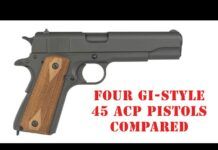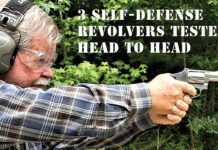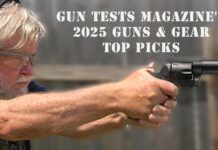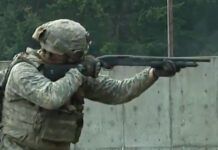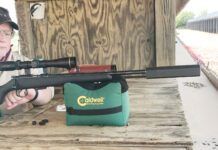In this test we will evaluate four small pistols chambered for shooter-friendly 9mm ammunition. All four of the pistols offer single-action fire and a thumb-operated safety to simplify operation.
Matching short slides to the proper-strength recoil spring can be challenging. All four of our test guns utilized a two-spring plunger-style guide-rod system that seems to be the answer to providing the proper balance of compression and rebound. Despite this operational similarity all four pistols offered their own unique features.
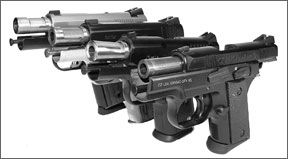
Three of our test pistols spring from the Browning 1911 design: the $1195 Kimber Aegis II, the $899 Para Ordnance Hawg 9, and the Springfield Armory EMP (Enhanced Micro Pistol), $1253. The fourth gun, the CZ USA 2075 Rami, $576, can be carried cocked and locked and cuts about the same profile as the 1911 models, and it may also be fired with a double-action first shot.
How We Tested
To test our little quartet for accuracy, we fired from a sandbag rest at targets placed 15 yards downrange. We also tried firing three-shot rapid-fire strings at a Hoffners ABC16 target from a distance of 5 yards. This target displays a humanoid silhouette surrounded by six auxiliary aiming points.
We performed the following drill in order to learn more about the fast-action handling of our test pistols:
The shooter began by facing the target, holding the gun with both hands level. Upon start signal we engaged the chest area A-zone
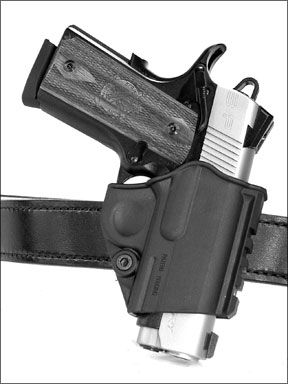
with two shots and followed up with a third shot to the B-zone head area. We recorded elapsed time and accuracy over the course of eight three-shot strings.
The purpose of this test was to determine if there were any aspects or features of each gun that prevented us from shooting aggressively. For this exercise we chose Black Hills remanufactured 115-grain JHP rounds. This ammunition was also fired from the bench, as well as Hornady 124-grain JHP/XTP rounds and 147-grain JHP Match Subsonic ammunition from Atlanta Arms and Ammo. It may come as a surprise that such small guns can be fired reliably with light recoiling ammunition, but we did not suffer any malfunctions with any of our guns during our tests.
Here is how they stacked up.
Springfield Armory
Enhanced Micro Pistol 9mm
P192029LP, $1253
The EMP cut the smallest overall profile among our four pistols. The alloy frame and steel slide were coated with a matte finish, black frame and satin stainless slide. Thin, fancy wood grips were applied as well as ambidextrous thumb-operated safeties.
The EMP included all of the Springfield Armory Loadeds features, such as ventilated aluminum trigger adjustable for overtravel, skeletonized hammer, memory groove grip safety, night sights, and checkered mainspring housing. The EMP utilized a bushingless bull barrel system, lowered and flared ejection port and beveled magazine well.
What the operator cant see was that along with shrinking the grip frame front to back, as many as fifteen different parts had to be scaled down to accommodate the change in size. Accordingly, the manufacturer refers to the EMP as being chambered for “short-action pistol cartridges.”
The Enhanced Micro Pistol arrived in a lockable plastic pistol case and two stainless-steel 9-round magazines produced by Mec-Gar of Italy. The base pad of each magazine added a final contour to the front strap and provided an impact point for seating the magazine.
There was also a form-fit holster and dual magazine pouch made of plastic. Each unit included accessory rails along the edges for storing a light or other accessory. The EMP was not fit with a rail for mounting a light.
We found an inscription on the belt side of the magazine carrier that read, “1911 EMP 9mm/40 S&W.” According to Springfield Armory a .40 S&W EMP is in the works. Unlike our experience with the bulkier XD pistol pack, the supplied holster proved to be a very good match for the little 1911, holding it smartly to our side. Made in Israel, both the magazine pouch and the holster were tension adjustable.
At the range we worried that the small size of the EMP would prevent us from settling the gun effectively on the bench. We neednt have worried. The Springfield was the only pistol to land sub-1-inch groups with each test ammunition.
In terms of power, the EMP finished second to the Para Ordnance Hawg 9 firing the Hornady ammunition, which proved to be the most powerful of our test munitions.
When handling the gun, we learned the small grip made it easier to quickly find the magazine release. We had expected the necessary reduction in size of the magazine well to hamper reloading, but Springfield beveled all four sides of the well, creating a slightly oval shape. This helped us insert a fresh magazine. Once the mag was in place, we were able to free the slide using the release lever or by pulling back the slide.
In our action test we discovered that pointing the gun and releasing the safety could be accomplished very quickly. We thought the EMP trigger was the most refined among our test pistols and reset was very fast. These characteristics let us shoot very aggressively and set the fastest times of our tests. Elapsed time ranged from 1.64 seconds to 1.86 seconds. In the A-zone only one shot struck left of center. Two shots were high of the B-zone but hit below the scalp line, and one shot found the lower jaw of the silhouette.
Overall, we felt that the EMP offered a fresh angle on 1911 ergonomics. For those with large hands, it initially felt small and perhaps lacked the traditional willingness to point that 1911s are famous for. But when nestled in the palm, control during rapid fire was reassuring. For the shooter with small hands, the EMP should offer unparalleled ergonomics.
Kimber Aegis II 9mm, $1195
In Greek mythology the
aegis was the shield of Zeus. In Kimbers parlance, the Aegis II is much more offense-minded.
Its a small alloy-framed 1911 chambered for 9mm and fed from a single-column magazine. The Kimber Aegis II differs primarily from the Springfield Armory EMP by being built on a frame with grip and magazine well of standard 1911 dimensions. The 8-round MetalForm 9mm magazine shared the same outer dimensions as a typical .45 ACP magazine.
But the Aegis offered a very distinctive look and feel of its own. The frame had a frosted silvery gray appearance that Kimber refers to as Satin Silver. The backstrap consisted of a 20-lpi -checkered mainspring housing that looked abbreviated seated below a full-size grip safety with raised platform. The front of the grip frame was checkered with a fine 30-lpi grid. We prefer manufacturers checkering on alloy models to aftermarket work because it is common for the original surface coating to be applied with a surface tension that plays a part in the integrity of the frame. Kimbers checkering on the Aegis II was first rate.
The magazine release button was left smooth and contoured with a forward radius. In fact, the entire gun had been “melted,” meaning that all corner edges of the frame had been smoothed to make it more slippery in and out of a holster or concealment garment. The rear-only cocking serrations were mild and widely spaced. The edges at the front and rear of the dark-colored slide were also rounded. The thumb safety was left side only and the contact area was minimized. Of our four pistols we thought that the Aegis was the most snag free.
The wood-grip panels sported three deep grooves on each side. The aluminum trigger was not relieved, giving the Aegis a sophisticated retro-look. The slide was flat-topped dropping away from the night sights front and rear. The ejection port was cut and flared. Like our other two 1911s, the Aegis worked from a bushingless bull barrel. All three of our 1911s were fit with a reduced-mass hammer. Instead of offering a skeletonized hammer with tang, the Kimber hammer was flat. Because this hammer sat flush when lowered, it could not be thumbed. In the event of a misfire the shooter will not be able to thumb back the hammer and attempt a second strike. Instead, hed have to rack the slide and chamber a fresh round.
The magazine well was beveled to enhance reloading. But the bases of the two supplied magazines were left without an extended pad, offering a flush fit to enhance concealment. Extended base pads can help ensure seating of the magazines. Two holes were drilled and tapped into the bottom of the magazines, so adding “slam pads” as they are sometimes called would be simple.
The Aegis offered a strong natural index. The smooth grip panels played a lesser part in adding grip than did the checkering on the narrow frame fore and aft. The thumb safety, though minimal, was easy to find. Firing the Aegis aggressively, we had no trouble completing all strings in our action test in less than 2 seconds. Our test shooters landed hits in a narrow range of 1.83 to 1.99 seconds. We pushed two of sixteen shots just left of the A-zone and landed four of eight shots just above the cranial pocket.
From the bench the Aegis favored the hotter defense loads, delivering groups that averaged about 1.75 inches with both the Hornady and Black Hills hollowpoint ammunition. What we liked best about the Kimber Aegis was that it faithfully translated the best handling characteristics of a full-size 1911 into a package that was light, smooth and concealable.
Para Ordnance Hawg 9
WHX129RR 9mm, $899
As many as eight different Hawg pistols are listed on the paraord.com website. This includes the Slim Hawg single-stack 45s, and six models fed from double-column magazines, four widebody .45s and two widebody 9mms. Of the two 9mm models, the Lite Hawg 9 offers an accessory rail on the dustcover and all-black appearance.
Our Hawg 9 was prettier, in our view, with contrasting satin stainless parts such as the grip screws, slide release, left side only thumb safety, magazine release, short grip safety, and frame pins. Supplied sights were non-luminous three dot sights with the rear sight face rounded in profile and lined to reduce glare. Magazine capacity for each 9mm Hawg was 12+1. Two 12-round magazines were supplied. One had a flat base pad, and the other had an extension that added space for the third finger to grip the gun.
Shooting impressions among our staff were about evenly divided between those shooters with big cushy palms and those with thinner, bonier hands. This was because when holding the Hawg 9, the back strap, or rather the short mainspring housing, did not fill the entire hand. The bottom edge of the mainspring housing was abrupt and tended to apply the most pressure on the soft tissue below the thumb and along the outer edge of the hand just above the wrist.
For those with larger mitt-like hands, this did not seem to be an issue. Those with less meaty hands benefited from holding the gun with the thumb underneath the safety. This grip tended to puff out the tissue below the thumb and make shooting more comfortable.
The supplied sights were the same as found on the other larger Para Ordnance pistols we have tested. The profile was that of a semi-circle with two white dots on either side of the notch. We found articulating proper alignment in terms of elevation to be frustrating, and shooting from the bench, our shots printed higher than our point of aim. Perhaps the front sight was merely the wrong height. But asking the shooter to find top dead center of a circle is more difficult than lining up the top edge of the front sight with the horizontal line created by a typical rectangular rear sight blade.
The short sight radius of the Hawg 9 may also have contributed to our difficulty in landing tighter groups closer to point of aim. Nevertheless, we did manage to shoot groups measuring about 1.5 inches across with both the Hornady and Black Hills ammunition. The Hawg 9 also produced the most velocity and muzzle energy among our four pistols. We did notice, however, that after inserting a magazine the only way we could get the slide to move forward was by pressing down on the release lever. But simple chores like dropping the magazine clear of the palm were executed cleanly. Reloading the Hawg 9 was also simpler and faster than the narrow-gripped Springfield Armory and Kimber pistols.
In our action test we were able to set an average elapsed time of about 2.25 seconds. Some of our staff found it difficult to acquire an optimum grip, and even at 5 yards we felt the sight picture slowed us down. Four of sixteen hits were out of the A-zone, three at the proper level but pushed left by the shooter, and another landed high. Hits to the head were centered properly, but three of five were above the B-zone.
CZ USA 2075 Rami 9mm, $576
The CZ is an aluminum framed traditional double-action pistol with manual safety that feeds from a double-column magazine. It came with one flush-fitting magazine that can be loaded with 10 rounds and one 14-round magazine. This magazine was fit with a collar to extend the grip front and rear, creating an ideal grip accommodating all four fingers. However, we found that the shooters hold suffered little in comparison with the shorter 10-round magazine in place. In each case the operator had to be careful to move the hand completely out of the way to drop the magazine clear of the palm.
The fully checkered grip panels were rubber and added little to the width of the pistol. The frame featured a beavertail that helped control recoil and shield the web of the hand from the edges of the slide. The trigger guard was undercut and the magazine release button was blended into place without being lost to the operator.
The slide release and the thumb safety were left side only. The slide, which rode on the frame with the rails tucked inside the frame, was serrated front and rear and carried an external extractor. CZ USA did not blend all the edges of the 2075 Rami but did round them off considerably around the muzzle.
The 2075 Rami may be carried cocked and locked for first shot single action or, carried with the hammer in half cock for a double action first shot. Subsequent shots will fire single action only. The 2075 Rami did not have a grip safety nor did it have a decocking lever. The hammer must be brought to the half cock position manually. This was achieved by holding the hammer and pressing the trigger but just for a moment. Hold the trigger back and let the hammer go and the gun was capable of igniting a round.
The safest way we found to decock the 2075 Rami was to hold the hammer by the thumb and forefinger with a portion of the finger between the hammer face and the firing pin. Then press the trigger as if it were a push button releasing it immediately after it made a distinctive clicking sound. Now it was safe to let the hammer forward. The hammer would then catch in the half cock position about 0.30 inches from the rear of the slide. Return to single action fire could be achieved by simply thumb cocking the weapon.
From the bench our CZ finished second overall by landing five-shot groups averaging 1.7 inches firing the Hornady 124 grain JHP/XTP rounds, 1.4 inches for the Black Hills 115-grain JHP ammunition, and 1.8 inches firing the Atlanta Arms and Ammo 147 grain Match. We think 115-grain ammunition would be the best bet for the Rami.
What we learned about handling the CZ made us like it less. Beginning each string with the hammer back on safe, on our elapsed times ranged from 2.98 seconds to 3.43 seconds, by far the slowest in our tests. The safety was stiff and lacked enough surface for the thumb to take hold of. Even after it had loosened up a little with use, its flat profile prevented us from being really aggressive.
Ideally, the shooter should be able to disengage the safety during the push towards the target in such a manner that it is second nature and barely noticeable. Shooting double action to single action, average elapsed times dropped to 2.05 seconds. Despite the longer sweep of the trigger and longer reset times for the hinged trigger action, taking the safety out of the equation made short work of the first shot. Only one shot strayed right of the A-zone and a single shot printed high but on the center of the forehead of our silhouette target.
With lessons learned from our action test and experience handling the hammer and trigger of the 2075 Rami, we put together what we think is a reasonably safe and effective way to handle this weapon. Carrying the Rami with the hammer in half cock seems like a good idea to us. Should the gun be fired under stress, the safety should be applied before re-holstering. Decocking under stress could lead to making a costly mistake, in our view.
Gun Tests Recommends
Springfield Armory EMP Enhanced Micro Pistol 9mm P192029LP, $1253. Our Pick. Scaled down without compromise, our EMP performed the best. If you have small hands, it will fit you better than any other gun we know.Kimber Aegis II 9mm, $1195. Buy It. Great looks plus excellent point and shoot handling are the Aegis greatest strengths. Slick and snag free, Kimbers first-class checkering added grip where it counted.Para Ordnance Hawg 9 WHX129RR 9mm, $899. Conditional Buy.High capacity is a plus in our view, but fit was not for everybody. The Hawg 9 would also benefit from a careful choice of sights.CZ USA 2075 Rami 9mm, $576. Conditional Buy. The 2075 had the highest capacity, scored well from the bench and in our action test. But without a decocker, we just dont think its right for most shooters. GT
FEB-SPRINGFIELD-ARMORY-MICRO.pdf




